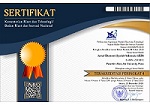Analisis Persepsi Maslahah Dalam Melakukan Pembelian Kompulsif
Abstract
Abstract
This study aims to determine the effect of the perception of maslahah on compulsive buying behavior This research is a quantitative research by integrating the dimensions of maslahah perception into the Theory of Planned Behavior (TPB) model. TPB is an integrated model that consists of four predictors of behavior, namely attitudes, subjective norms, perceived behavioral control (PBC), and intentions to behave. Sampling using Purposive Sampling, that is 200 respondents. To measure the variables using the Continuous rate scale. While the data analysis technique used in this research is path analysis using Smart PLS 2.0 (Partial Least Square) software. The results of the study said that the maslahah perception construct had a significant effect on the attitude construct even though it was weak at 5.5%. Which means there are still about 94.5% of the attitude variables are influenced by other factors. Then the attitude construct has a significant effect on the compulsive buying behavior construct of 47.6%, which means that there are still around 52.4% of the variable Compulsive Buying Behavior which can be explained from other factors. While the construct of subjective norms and behavioral control has no effect on compulsive buying behavior. The reason for the rejection of these two hypotheses is thought to be because Muslim communities who have high subjective norms and behavioral control do not change their behavior in compulsive buying to be higher.
Keywords: Maslahah, Compulsive Buying, Theory of Planned BehaviourFull Text:
PDFReferences
REFERENCES
Abu Ishaq al- Syatibi. (n.d.). Al Muwafaqat Fi Usul Al Syaria’ah (juz I). Beirut: Dar Al Kutub Al Ilmiyyah.
Afdalia, Nadhira, D. (2010). Theory of Planned Behavior Dan Readiness for Change Dalam Memprediksi Niat Implementasi Peraturan. Jaai, 18(2), 110–123.
Ajzen, I., & Driver, B. L. (1991). Prediction of leisure participation from behavioral, normative, and control beliefs: An application of the theory of planned behavior. Leisure Sciences, 13(3), 185–204. https://doi.org/10.1080/01490409109513137
Akhadiyah, R. F. (2017). PERILAKU PEMBELIAN KOMPULSIF PRODUK FASHION ( SurveiPadaKonsumen Fashion Malang Town Square Di Kota Malang ), 48(1), 19–27.
Bahsoan, A. (2011). Mashlahah sebagai Maqashid al Syariah: Tinjauan dalam Perspektif Ekonomi Islam. INOVASI, 8(1).
Bimo, W. (2010). Pengantar Psikologi Umum. Yogyakarta: Andi Offset.
Elvira, R. (2016). Pengaruh Persepsi Konsumen Muslim Tentang Maslahah Terhadap Keputusan Konsumsi Terbatas Hanya Pada Komoditas Halal (Studi: Mahasiswa Fakultas Syariah dan Ekonomi Islam Tahun 2015). Manhaj, 04(02).
Icek Ajzen. (n.d.). Teori direncanakan perilaku: Reaksi dan Refleksi. University of Massachusetts, 199.
Jogiyanto, W. A. (2014). Konsep Aplikasi PLS (Partial Least Square) Untuk Penelitian Empiris. Yogyakarta: BPFE.
Kartika, K., & Utami, D. (2018). The Effect of Attitude Toward the Behavior , Subjective Norm and Perceived Behavioral Control on Whistleblowing Intention. Journal of Finance and Accounting, 9(18), 1–5.
Kotler, P. (1999). Manajemen Pemasaran (Edisi Terj). Jakarta: Indeks.
Muflih, M. (2006). Perilaku Konsumen Dalam Perspektif Ilmu Ekonomi Islam. Jakarta: PT Raja Grafindo.
Muhammad. (2004). Ekonomi Mikro dalam Perspektif Islam. Yogyakarta: BPFE Yogyakarta.
Nugroho, A. P. (2015). Pengaruh Religiusitas Dan Efikasi Diri Terhadap Perilaku Menabung Di Perbankan Syariah. Disertasi Doktor, 131–170.
Rahim, A. (2013). Ekonomi Islam Perspektif Muhammad saw. Jember: Stain Jember: Press.
Sari, R. K. (2016). Kecenderungan perilaku compulsive buying (pembelian kompulsif) pada masa remaja akhir di Samarinda. Jurnal Psikologi, 4(4), 361–372. Retrieved from http://ejournal.psikologi.fisip-unmul.ac.id/site/wp-content/uploads/2016/03/JURNAL RATIH - ONLINE (03-11-16-03-10-59).pdf
Solomon, M. . (2009). Consumer behavior: buying, having, and being. Upper Saddle River, New Jersey: Prentice-Hall.
Sugiyono. (2015a). Metode Penelitian Pendidikan: Pendekatan Kuantitatif, Kualitatif, dan R&D. Bandung: Alfabeta.
Sugiyono. (2015b). Metode Penelitian Pendidikan: Pendekatan Kuantitatif, Kualitatif, dan R&D. Bandung: Alfabeta.
Supriadi, Y. (2013). Periklanan Perspektif Ekonomi Politik. Bandung: PT. Remaja Rosdakarya Offset.
Ujang Sumarwan, dkk. (2011). Riset Pemasaran Dan Konsumen. Bogor: CV. IPB Press.
Ilmiah, D. (2020). Optimalisasi asset wakaf melalui sukuk wakaf di indonesia. JESI (Jurnal Ekonomi Syariah Indonesia), 9(2), 127-137.
Ilmiah, D. (2020). Peran Perbankan Syariah Dalam Implementasi Wakaf Uang Untuk Pengembangan Industri Halal Di Jawa Timur. DINAMIKA: Jurnal Kajian Pendidikan Dan Keislaman, 5(2), 1-20.
Yunadi, A. (2020). Maqasid as-Syari’ah dan Asuransi Syari’ah. JESI (Jurnal Ekonomi Syariah Indonesia), 10(2), 159-172.
DOI: http://dx.doi.org/10.21927/jesi.2021.11(2).92-100

This work is licensed under a Creative Commons Attribution-ShareAlike 4.0 International License.












